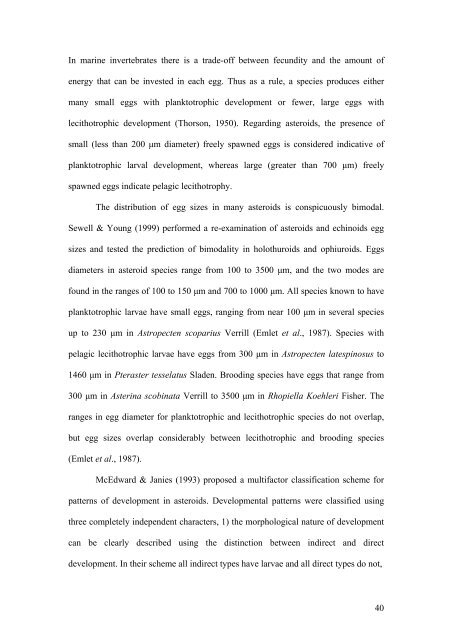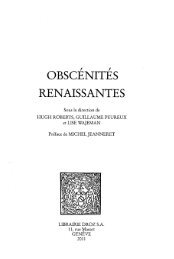Download (3398Kb) - ePrints Soton - University of Southampton
Download (3398Kb) - ePrints Soton - University of Southampton
Download (3398Kb) - ePrints Soton - University of Southampton
You also want an ePaper? Increase the reach of your titles
YUMPU automatically turns print PDFs into web optimized ePapers that Google loves.
In marine invertebrates there is a trade-<strong>of</strong>f between fecundity and the amount <strong>of</strong><br />
energy that can be invested in each egg. Thus as a rule, a species produces either<br />
many small eggs with planktotrophic development or fewer, large eggs with<br />
lecithotrophic development (Thorson, 1950). Regarding asteroids, the presence <strong>of</strong><br />
small (less than 200 µm diameter) freely spawned eggs is considered indicative <strong>of</strong><br />
planktotrophic larval development, whereas large (greater than 700 µm) freely<br />
spawned eggs indicate pelagic lecithotrophy.<br />
The distribution <strong>of</strong> egg sizes in many asteroids is conspicuously bimodal.<br />
Sewell & Young (1999) performed a re-examination <strong>of</strong> asteroids and echinoids egg<br />
sizes and tested the prediction <strong>of</strong> bimodality in holothuroids and ophiuroids. Eggs<br />
diameters in asteroid species range from 100 to 3500 µm, and the two modes are<br />
found in the ranges <strong>of</strong> 100 to 150 µm and 700 to 1000 µm. All species known to have<br />
planktotrophic larvae have small eggs, ranging from near 100 µm in several species<br />
up to 230 µm in Astropecten scoparius Verrill (Emlet et al., 1987). Species with<br />
pelagic lecithotrophic larvae have eggs from 300 µm in Astropecten latespinosus to<br />
1460 µm in Pteraster tesselatus Sladen. Brooding species have eggs that range from<br />
300 µm in Asterina scobinata Verrill to 3500 µm in Rhopiella Koehleri Fisher. The<br />
ranges in egg diameter for planktotrophic and lecithotrophic species do not overlap,<br />
but egg sizes overlap considerably between lecithotrophic and brooding species<br />
(Emlet et al., 1987).<br />
McEdward & Janies (1993) proposed a multifactor classification scheme for<br />
patterns <strong>of</strong> development in asteroids. Developmental patterns were classified using<br />
three completely independent characters, 1) the morphological nature <strong>of</strong> development<br />
can be clearly described using the distinction between indirect and direct<br />
development. In their scheme all indirect types have larvae and all direct types do not,<br />
40
















